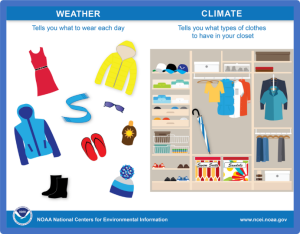2 What is the difference between weather and climate?
Climate is NOT the same as Weather
Have you ever seen comments on social media like this: “We had record breaking cold this New Year’s, how could there be global warming?” Record-breaking cold is an example of weather, NOT climate.
Weather refers to short-term changes to local atmospheric conditions such as air temperature, humidity, wind, and cloud cover. Short-term changes typically occur within minutes, hours, or days. [1] In contrast, climate refers to the long-term averages of these variables, at least 30 years or longer, calculated at the local, regional or global scale. [2] In other words, climate is the weather of a region averaged over a long period of time.
It is essential to distinguish between weather and climate to understand the science behind climate change. Just because there was a freezing day in one location doesn’t mean that global warming isn’t real. As mentioned, to identify global climate trends, it is necessary to look at lots of data over a long period of time. If someone focuses on weather statistics in one area, they might miss long-term global climate trends. Watch the video for a visual example of the differences between short-term variations and long-term trends.
Dressing for the Climate and Dressing for the Weather
One way to help remember the difference between weather and climate is to think about your wardrobe. If you live in a location with four seasons—winter, spring, summer, and fall—you know that you put away your heavy sweaters after winter and get out your short sleeve shirts and shorts in summer. The clothing essentials you need for the season are based on climate patterns. That is, you expect cold weather in winter and warm in summer. What you choose to wear on a particular day is based on the weather. For example, if it is raining when you wake up on Monday you may choose to put on a raincoat. If it is sunny on Tuesday, you may choose to wear sunglasses and a sun hat. [3]

- "Global Warming Vs. Climate Change." NASA: Global Climate Change Vital Signs of the Planet, climate.nasa.gov/global-warming-vs-climate-change/. Accessed 23 May 2023. ↵
- On the basis of an international agreement of climatologists, a period of three consecutive decades, or 30 years, is commonly used to describe climate at a given location. See World Meteorological Organization. 1989. Calculation of Monthly and Annual 30-Year Standard Normals. WCDP-No. 10, WMO-TD/No. 341. Geneva: World Meteorological Organization. ↵
- What's the difference between weather and climate? National Centers for Environmental Information (NCEI). (2021, October 22). Retrieved October 13, 2022, from https://www.ncei.noaa.gov/news/weather-vs-climate ↵
Short-term changes to local atmospheric conditions such as air temperature, humidity, wind, and cloud cover. Short-term changes typically occur within minutes, hours, or days.
Climate in a narrow sense is usually defined as the “average weather,” or more rigorously, as the statistical description in terms of the mean and variability of relevant quantities over a period of time ranging from months to thousands of years. The classical period is 3 decades, as defined by the World Meteorological Organization (WMO). These quantities are most often surface variables such as temperature, precipitation, and wind. Climate in a wider sense is the state including a statistical description, of the climate system. (IPCC 2018)
